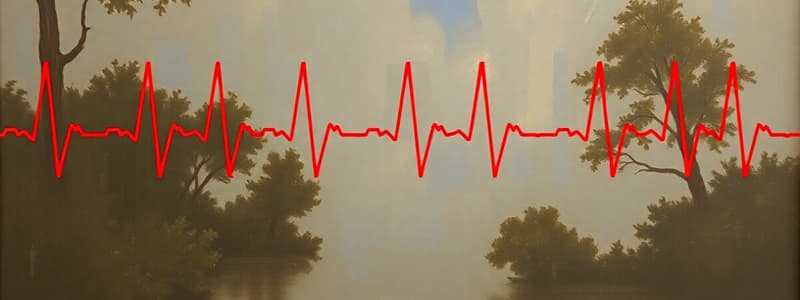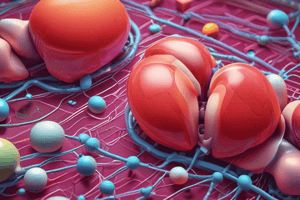Podcast
Questions and Answers
Which of the following conditions is classified as bradycardia?
Which of the following conditions is classified as bradycardia?
- Heart rate greater than 100 bpm
- Heart rate between 60 and 100 bpm
- Heart rate fluctuating widely
- Heart rate less than 60 bpm (correct)
What is a primary physiological cause of sinus tachycardia?
What is a primary physiological cause of sinus tachycardia?
- Electrolyte imbalance
- Acute stress (correct)
- Heart block
- Excessive vagal tone
Which drug is commonly used for the treatment of sinus bradycardia?
Which drug is commonly used for the treatment of sinus bradycardia?
- Calcium-channel blocker
- Amiodarone
- Digoxin
- Atropine (correct)
What underlying mechanism characterizes ventricular tachycardia?
What underlying mechanism characterizes ventricular tachycardia?
Which best describes atrial fibrillation?
Which best describes atrial fibrillation?
What is a major contributing factor to the development of premature ventricular complexes (PVC)?
What is a major contributing factor to the development of premature ventricular complexes (PVC)?
The Vaughn-Williams classification scheme is used to categorize which type of drugs?
The Vaughn-Williams classification scheme is used to categorize which type of drugs?
What is the primary effect of Class IV antiarrhythmic drugs?
What is the primary effect of Class IV antiarrhythmic drugs?
Which class of sodium channel blockers has the strongest blockade?
Which class of sodium channel blockers has the strongest blockade?
What is a therapeutic indication for Class IA antiarrhythmic drugs?
What is a therapeutic indication for Class IA antiarrhythmic drugs?
Which drug belongs to Class IB antiarrhythmics?
Which drug belongs to Class IB antiarrhythmics?
How does Class IA antiarrhythmic drugs primarily affect the action potential duration?
How does Class IA antiarrhythmic drugs primarily affect the action potential duration?
What is the primary action of beta-blockers in treating arrhythmias?
What is the primary action of beta-blockers in treating arrhythmias?
What is the effect of Class IB sodium channel blockers on action potential duration?
What is the effect of Class IB sodium channel blockers on action potential duration?
Which of the following Class IA drugs has strong anticholinergic effects?
Which of the following Class IA drugs has strong anticholinergic effects?
Which Class IC drug can induce life-threatening ventricular tachycardia?
Which Class IC drug can induce life-threatening ventricular tachycardia?
What is the primary mechanism of Class I antiarrhythmic drugs?
What is the primary mechanism of Class I antiarrhythmic drugs?
Which class of antiarrhythmic drugs is most effective in treating tachycardia related to reentry mechanisms?
Which class of antiarrhythmic drugs is most effective in treating tachycardia related to reentry mechanisms?
Which drug is NOT classified within the Vaughan-Williams classification system?
Which drug is NOT classified within the Vaughan-Williams classification system?
What pharmacologic effect does Class II antiarrhythmic drugs mainly provide?
What pharmacologic effect does Class II antiarrhythmic drugs mainly provide?
Which subclass of Class I antiarrhythmic drugs has a strong effect on phase 0 slope?
Which subclass of Class I antiarrhythmic drugs has a strong effect on phase 0 slope?
Which class of antiarrhythmic drugs delays repolarization and prolongs the action potential duration?
Which class of antiarrhythmic drugs delays repolarization and prolongs the action potential duration?
What is a common side effect of many Class I and III antiarrhythmic drugs?
What is a common side effect of many Class I and III antiarrhythmic drugs?
What does Class IV antiarrhythmic drugs primarily block?
What does Class IV antiarrhythmic drugs primarily block?
Which of the following statements is incorrect regarding tissue ablation for treating tachycardia?
Which of the following statements is incorrect regarding tissue ablation for treating tachycardia?
Flashcards
Bradycardia
Bradycardia
A slow heart rate, below 60 beats per minute (bpm).
Sinus bradycardia
Sinus bradycardia
A type of bradycardia where the slow heart rate is caused by the SA node (the heart's natural pacemaker) not working properly.
Ventricular bradycardia
Ventricular bradycardia
A type of bradycardia caused by problems in the heart's conduction system, making the ventricles beat slower than usual.
Sinus tachycardia
Sinus tachycardia
Signup and view all the flashcards
Atrial fibrillation
Atrial fibrillation
Signup and view all the flashcards
Premature ventricular complex (PVC)
Premature ventricular complex (PVC)
Signup and view all the flashcards
Ventricular tachycardia
Ventricular tachycardia
Signup and view all the flashcards
Vaughan-Williams Classification
Vaughan-Williams Classification
Signup and view all the flashcards
Class I Antiarrhythmic Drugs
Class I Antiarrhythmic Drugs
Signup and view all the flashcards
Class II Antiarrhythmic Drugs
Class II Antiarrhythmic Drugs
Signup and view all the flashcards
Class III Antiarrhythmic Drugs
Class III Antiarrhythmic Drugs
Signup and view all the flashcards
Class IV Antiarrhythmic Drugs
Class IV Antiarrhythmic Drugs
Signup and view all the flashcards
Tachycardia
Tachycardia
Signup and view all the flashcards
Tissue Ablation
Tissue Ablation
Signup and view all the flashcards
Proarrhythmic Activity
Proarrhythmic Activity
Signup and view all the flashcards
What is the mechanism of action for Class IV antiarrhythmics?
What is the mechanism of action for Class IV antiarrhythmics?
Signup and view all the flashcards
What is the general mechanism of action for Class I antiarrhythmics?
What is the general mechanism of action for Class I antiarrhythmics?
Signup and view all the flashcards
What are the characteristics of Class IA antiarrhythmics?
What are the characteristics of Class IA antiarrhythmics?
Signup and view all the flashcards
What are the characteristics of Class IB antiarrhythmics?
What are the characteristics of Class IB antiarrhythmics?
Signup and view all the flashcards
What are the characteristics of Class IC antiarrhythmics?
What are the characteristics of Class IC antiarrhythmics?
Signup and view all the flashcards
What are the additional mechanisms of Class IA antiarrhythmics?
What are the additional mechanisms of Class IA antiarrhythmics?
Signup and view all the flashcards
What are the additional mechanisms of Class I antiarrhythmics, beyond sodium channel blockade?
What are the additional mechanisms of Class I antiarrhythmics, beyond sodium channel blockade?
Signup and view all the flashcards
What is the mechanism of action of Class ID antiarrhythmics?
What is the mechanism of action of Class ID antiarrhythmics?
Signup and view all the flashcards
What is the general mechanism of action for Class II antiarrhythmics?
What is the general mechanism of action for Class II antiarrhythmics?
Signup and view all the flashcards
Study Notes
Arrhythmias and Antiarrhythmic Drugs
- Lecture 3 covers arrhythmias and antiarrhythmic drugs.
- Learning objectives include describing various arrhythmias (sinus bradycardia, ventricular bradycardia, sinus tachycardia, atrial tachycardia/fibrillation, premature ventricular complexes, and ventricular tachycardia) and recognizing them on ECGs.
- Objectives also include understanding how abnormal automaticity and reentry cause arrhythmias.
- Identifying causes of abnormal conduction, utility/limitations of the Vaughn-Williams classification scheme, and specific drug effects on ion channels and conduction are also included.
- The lecture details how drugs (adenosine, atropine, and ivabradine) are used in treating arrhythmias.
Abnormal Heart Rates
- Abnormal heart rates include bradycardia (rates below 60 bpm) and tachycardia (rates above 100 bpm). These can be normal or pathological.
- Bradycardia:
- Physiological causes: Highly trained athletes can exhibit resting heart rates as low as 40 bpm.
- Pathological causes: SAN ischemia, excessive vagal tone, electrolyte disorders, and drug use (beta-blockers, calcium channel blockers) are common.
- Tachycardia:
- Physiological causes: Exercise, acute stress (sympathetic activation).
- Pathological causes: Chronic stress, hyperthyroidism, fever/infections, structural/ischemic heart disease, and anemia.
Bradycardia (Rate < 60 bpm)
- Atrial (sinus) bradycardia:
- Physiological causes: highly trained athletes.
- Pathological causes: ischemia of the sinoatrial node (SAN), excessive vagal tone, electrolyte imbalances, and some medications.
- Ventricular bradycardia:
- Pathological: SA nodal failure, second-degree AV block (2° AV block), and third-degree AV block (3° AV block), often related to damage or degeneration of the His-Purkinje system.
- Treatment: addressing underlying causes (if possible), chronotropic drugs (like atropine, beta-agonists), or pacemaker implantation.
Tachycardia (Rate > 100 bpm)
- Sinus tachycardia:
- Physiological causes: Exercise, acute stress
- Pathological causes: Stress, hyperthyroidism, fever, infections, and structural/ischemic heart disease.
- Atrial tachycardia -Atrial flutter (250-350 bpm) -Causes: Structural/ischemic heart disease , Electrolyte disorders, thyroid disorders, medications/drugs/alcohol, Genetic diseases. -Atrial fibrillation (rapid, random depolarizations within atria). -Causes: Structural/ischemic heart disease, thyroid disease, excess catecholamines, medications & drugs/alcohol, and genetic diseases.
- Premature ventricular complex (PVC): -Spontaneous firing of ventricular ectopic foci. -Produces early/premature ventricular contraction. -Wide, atypical QRS complex.
- Ventricular tachycardia: -Pathological causes: Chronic stress, hyperthyroidism, fever/infection, structural/ischemic heart disease, and anemia. -Mechanism of electrophysiology includes rapid spontaneous firing of ectopic ventricular sites/afterdepolarization, and reentry (local/global).
Abnormal Conduction
- Prolonged PR interval, QRS, or QT interval often indicates problems with conduction pathways.
- Ischemic injuries to coronary arteries or severe hyperkalemia can affect conduction by altering cell depolarization and conduction velocity, often in non-nodal tissues.
- Abnormal pacemaker sites (like ectopic foci) and excessive vagal activation can also cause disruptions in conduction patterns.
Antiarrhythmic Drugs
- Vaughan-Williams classification categorizes antiarrhythmic drugs.
- Class I (sodium channel blockers: IA, IB, IC, ID).
- Class II (beta-blockers).
- Class III (potassium channel blockers).
- Class IV (calcium channel blockers).
- Drugs like adenosine, atropine, and ivabradine do not fit into these classes.
Class I Drugs
- These drugs block sodium channels in the heart, decreasing conduction velocity.
- Different classes (IA, IB, IC, ID) exhibit varying degrees of fast sodium channel blockade, altering action potential duration, effective refractory period, and conduction velocity.
Class II Drugs (Beta-blockers)
- Block sympathetic activation
- Slow ventricular rate by depressing AV nodal conduction
- Suppress abnormal automaticity and reentry arrhythmias
- Decrease slope of phase 4 and conduction velocity.
Class III Drugs
- Structurally diverse drugs that delay repolarization (phase 3) and raise action potential duration and effective refractory periods (ERP).
- Very effective in supraventricular and ventricular tachycardia caused by reentry.
- Increased Q-T interval can lead to potentially dangerous torsades de pointes (TdP).
Class IV Drugs (Calcium Channel Blockers)
- Block L-type calcium channels, primarily in SA and AV nodes.
- Reduce conduction velocity and lengthen action potential duration.
- Effective in supraventricular tachycardias involving AV nodal reentry.
Drugs Not Fitting into Vaughan-Williams
- Adenosine: Rapidly suppresses supraventricular tachycardia caused by AV nodal reentry.
- Atropine: Used to reverse AV block by blocking excessive vagal influences on nodal tissues, increasing SA node heart rate, and AV nodal conduction velocity.
- Ivabradine: Blocks sinoatrial funny currents, reducing heart rate without affecting other crucial heart functions.
Studying That Suits You
Use AI to generate personalized quizzes and flashcards to suit your learning preferences.
Related Documents
Description
This quiz covers Lecture 3 on arrhythmias and antiarrhythmic drugs. It addresses different types of arrhythmias, their recognition on ECGs, and the mechanisms behind abnormal heart rates. Additionally, it explores the Vaughn-Williams classification and the application of specific drugs in treatment.




